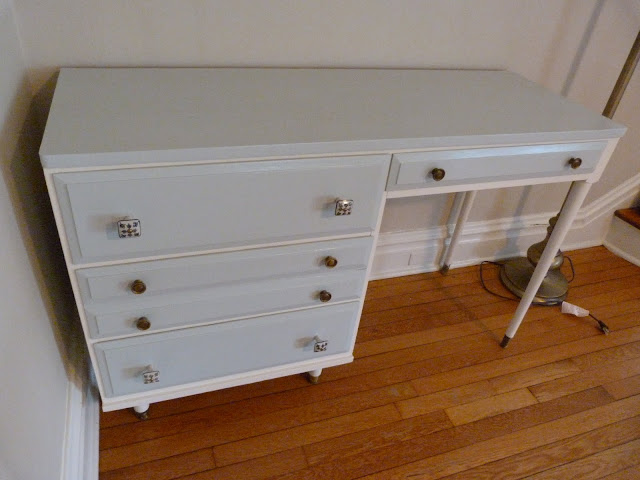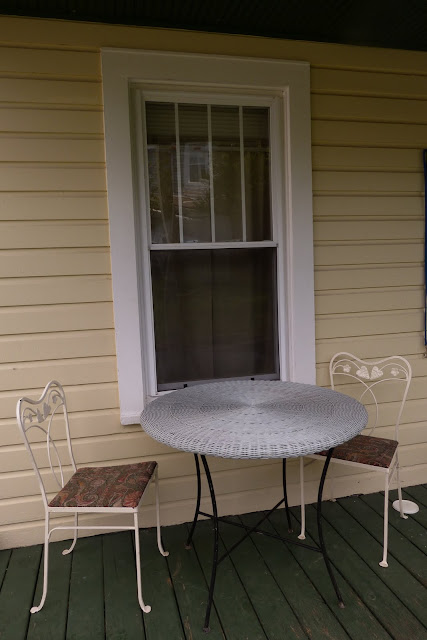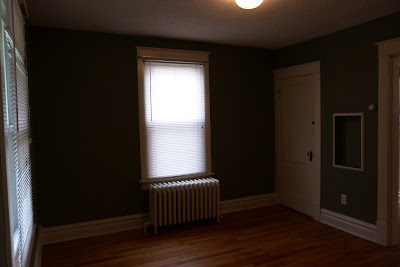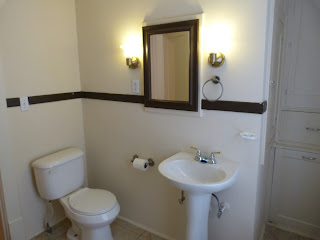Our first apartment was a tiny and dark basement apartment. It wasn't until we were moving out that we found out that our neighbors had dubbed it the "mold pit." While Jordan and I did a pretty good job of making the size issue work (we regularly crammed 20 people in a space that was probably about the size as our current living room), we never really got over the lack of light. When we walked through our second apartment, the first thing I noticed was the light. (Ok, maybe it was the second thing I noticed. I definitely took in the seemingly tripled size before I realized how much light there was.)
932 is brimming with light. There are windows everywhere. This thrills me. However, it also poses a bit of a privacy problem. While I am inexpressibly thankful that our home's previous owner left blinds on all of the windows in our house (with the exception of the sunroom windows), I simply can't handle plain white blinds without curtains. In all of my attempts to learn the rules and tricks of home design, I have learned that curtains, hung high and wide, make a drastic difference in the ambiance of a room. If you don't believe me, start taking note of home spaces to which you feel most drawn. I bet that you will find that window treatments make a world of difference in your perception of the space and, quite frankly, everything in that space.
But, let's face it. Curtains are expensive. I spent hours, days, and weeks, searching for affordable curtains. The curtains that I liked were anywhere between $20 and $50 a panel. Yep. Do the math. In a room that has two windows, that's between $80 and $200 for curtains. And that doesn't include curtain rods. Not happening.
Enter drop cloths. I had, at least a year ago, seen a DIY blogger on the Nate Berkus show (R.I.P.) make curtains from drop cloths and was astounded by their simple beauty. After searching for pre-made curtains and then for fabric, I decided that drop cloths were worth a try.
As I didn't have a sewing machine, I decided to use hem tape. This is on par with the greatest inventions ever. Seriously, all you need is hem tape and an iron and voila, you have a hem.
Here's the thing. A 6x9 drop cloth costs about $10 and is enough fabric for two panels. Hem tape costs between $3 and $5. Unpainted, that ends up being about $6 a panel. If you want to paint your curtains like I did, you may end up spending closer to $10-12. My living room curtains, all said in done, cost about $40.
Hemming the curtains is pretty self explanatory. Measure the length, floor to curtain rod, you need for your curtains. Cut the cloth to these measurements, remembering to leave a few inches on the top and bottom so that you can fold the fabric over and hem it. You can either make rod pockets or you can use curtain clip rings. I prefer the rings as they make the curtain much easier to move around on the rod, but rod pockets keep your cost down. Simply fold the fabric over and hem along the bottom of the fold so that you create a pocket at the top of your curtain.
Once you've hemmed the curtains, you can leave them as is or you can paint them. I made curtains for the dining room and living room. I painted the living room curtains, but have not yet painted the dining room curtains. They look great as-is, but I doubt I'll be able to resist painting them.
We painted stripes on the curtains. This is by far the easiest design. People do some pretty amazing things with paint and fabric. To paint stripes, make sure you use a measuring tape to ensure even spacing. Remember that you are painting between the tape, so you need to take the width of the tape into account. Trust me, this is hard to remember.
We used regular latex Olympic paint. I had paint leftover from painting the desk, and it was close to the color I wanted to use, so we went with it. We ended up using about a quart and a half on this project. To get the paint on the curtains, we used paint brushes, but you could use rollers as well.
To save yourself the headache of measure more than once, just line up your second panel with the first.
This was not a project without mishaps. I ruined an entire panel, halfway through the process because I absentmindedly began panting the wrong stripe. I was so angry.
The paint dried in a couple of hours and the curtains were ready to be hung!
We finished the project over the span of a week or two. It does take time. It takes me about an hour to cut and hem two panels and another hour to paint them.
Because of the width of the double windows and the length of the radiator underneath them, I decided to forgo my original plan of having two floor length curtains framing the window. The panels weren't quite wide enough to cover the windows and frankly, it just looked silly having the panels hanging with so much space in between. So, the solution was to make three shorter curtains for the window.
Obviously, a lot of other things have happened in the living room since your last glimpse, but, more on that another day.


















































